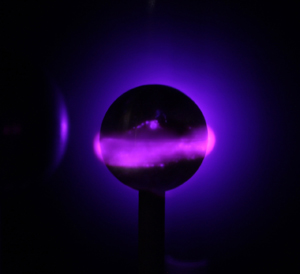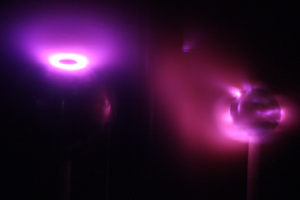A Hands-On Visual Demonstration of Space Weather

The Planeterrella is a new public outreach tool that models the Sun-Earth connection in miniature, demonstrating the amazing auroral lights up close.

The small sphere can also be modeled as Earth, with a "donut" of charged particles trapped around the equator, similar to the Van Allen Radiation Belts. These and other effects of the solar wind on Earth's magnetic shield, or magnetosphere, are collectively known as "space weather," which is important to study since powerful solar storms can damage critical satellites and even disrupt the global power grid.
[Today's Multiverse Guest Blogger is Emmanuel Masongsong, a passionate outreach educator with NASA's THEMIS/ARTEMIS mission team at UCLA. Today he talks about the Planeterrella, a miniature Earth model that can simulate the aurora (Northern Lights) and other plasma phenomena, the sight of which causes "children and adults to shriek with delight, 'ooh-ing' and 'aah-ing' at the eerie glow of plasma suspended in a ring before their very eyes."]
I had a pretty strong amateur astronomy background, but when I joined the team in early 2011, heliophysics, near-Earth electromagnetism, and space weather really forced me to expand my perception. Describing the immense electromagnetic phenomena in the solar wind and Earth's magnetic field requires specialized instruments and multiple spacecraft to observe what humans cannot actually see. One of the first things I realized about space weather is that the media and the public's attention are heavily weighted to the visible solar phenomena of flares and coronal mass ejections (CMEs)-- thanks to gorgeous images from SDO, SOHO, and STEREO. The news headlines harp on X-flares and devastating clouds of solar material (plasma) hurtling towards Earth, offering overly ambitious predictions of spectacular aurora that are not based on real-time satellite observations (and are thus usually disappointing).
So, otherwise, there is basically zero news coverage of the space weather processes in the solar wind and Earth's magnetosphere, which is sad since this is where a solar storm's hazardous effects are determined. Although the electromagnetic fields and plasmas we study with THEMIS/ARTEMIS are invisible and esoteric, they are of great import to our modern space-faring and electrically-dependent civilization. Radio communications, GPS mapping, automated farming equipment, and even drones are now under threat, not to mention our astronauts and global electrical grid, yikes! The public deserves to know more about the fascinating story of our near-Earth electromagnetic environment, which would help them appreciate how our heroic heliophysics satellites endure the solar onslaught 24/7 in order to help us predict space weather hazards.

The charged gas forms a ring around the north pole of the larger sphere, similar to the "auroral ring" that forms around the magnetic poles of Earth, Jupiter, and Saturn.
While discussing this disparity with colleagues, someone mentioned they had heard of a visualization tool built in the late 1800s called a "terrella" (i.e., "miniature Earth") that could simulate auroral lights and other plasma phenomena in a vacuum chamber using electricity and magnet-filled metal spheres. I realized that this was what I was searching for: a hands-on visual demonstration of space weather! Since the physics jargon of space weather is way over most people's heads, an interactive model could help them form a tangible connection to space weather and the aurora, bringing wider attention to our work. Most important, exciting visuals can inspire kids to pursue science and careers in space research, and also convey the importance of space weather to society at large. After some googling I contacted Dr. Jean Lilensten at Université Joseph Fourier - Grenoble in France, who painstakingly reviewed the original terrella and developed a safer, modernized version called the "Planeterrella" for educational and outreach purposes. There are already several of these showcased in museums and universities in Europe to great acclaim, so I knew we had to have one in the US.
Construction began in early 2012, and with the generous help of some undergraduate engineers it debuted at UCLA's Exploring Your Universe event in November 2013. Needless to say, it was a hit, and the line to see it was nearly out the door! The public always enjoys watching dazzling video footage of the sun, as well as auroras in the sky and from the space station as part of our usual exhibit. However the Planeterrella made children and adults shriek with delight, "ooh-ing" and "aah-ing" at the eery glow of plasma suspended in a ring before their very eyes. A common remark was "this is what is happening in space? Wow, I had no idea!" to which I would proudly smile and nod. The Planeterrella has since traveled all over Los Angeles and exposed thousands of people to the amazing dance of electricity and magnetism that occurs around our planet. They are also glad to learn that THEMIS/ARTEMIS and our other heliophysics satellites are up there, helping to unravel the mysteries of space weather and the Sun-Earth connection.
More Web Resources:
1153